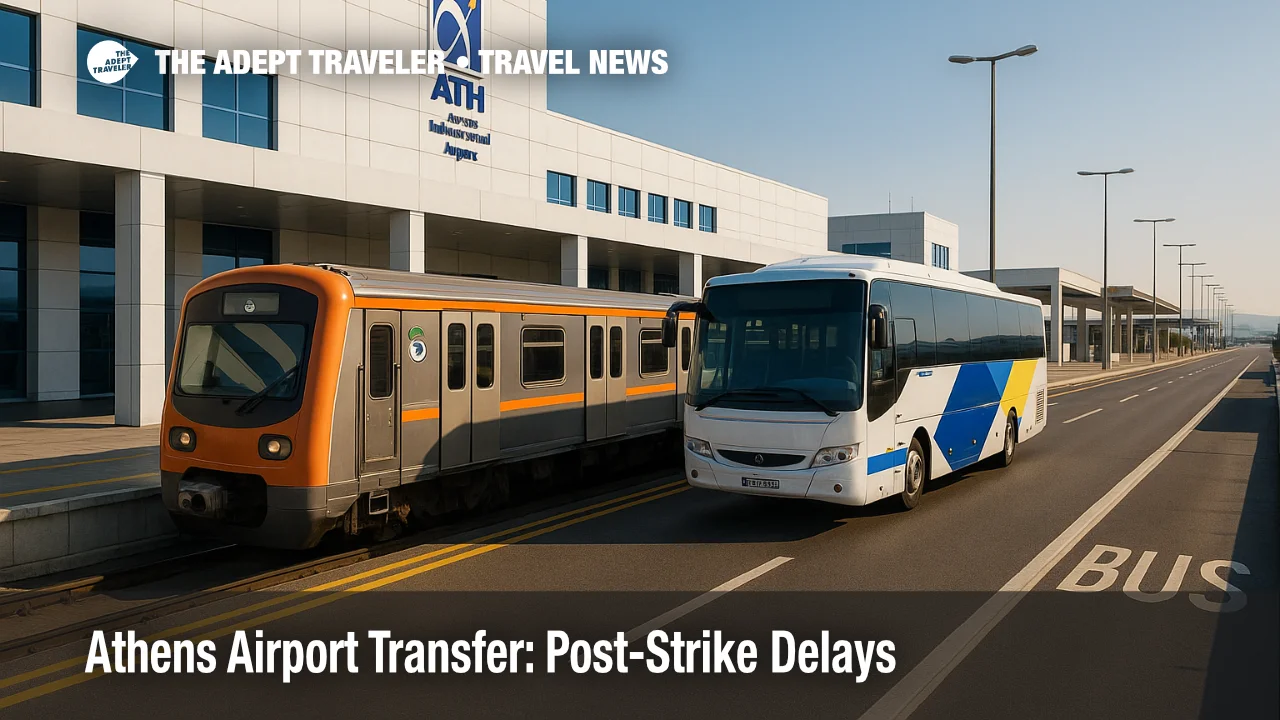Athens strike aftermath: plan extra time for Athens airport transfer

Athens is still working through the aftermath of Greece's October 1 general strike, and cleanup plus rolling demonstrations may leave gaps in metro, bus, and suburban rail service. Flights at Athens International Airport (ATH) are operating, but ground access remains the bigger risk. Travelers should confirm their airport transfer on the day of travel and allow additional margin, especially if passing near Syntagma or other rally corridors.
Key points
- Why it matters: Uneven transit frequencies can upend well-timed ATH connections.
- Travel impact: Expect irregular metro, bus, and suburban rail intervals during service normalization.
- What's next: Police may reopen central corridors in stages, causing short-notice detours.
- Flights continue at ATH, but prior ATC capacity limits may still cause delays at peaks.
- Build 30-60 extra minutes into any Athens airport transfer until service stabilizes.
Snapshot
Greece's 24-hour general strike on October 1 halted taxis and trains nationwide and tied up ferries. In Athens, the metro, tram, and the ISAP electric railway ran only limited daytime windows, while buses and trolleybuses operated reduced hours. A court decision kept aviation unions from walking out, so flights largely operated, though earlier flow restrictions in ATH airspace created knock-on delays. As cleanup continues and police scale back protest cordons, public transport may cycle through longer headways or temporary station closures near Syntagma and Panepistimio. If your route to ATH depends on Line 3 or buses that cross central Athens, verify service shortly before departure, consider hotel-arranged transfers familiar with detours, and leave a wider buffer for check-in and security.
Background
Labor federations called the nationwide action to protest proposed labor-law changes. The strike paused taxis in Attica, suspended ferries, and disrupted Hellenic Train services, while Athens city transit shrank to short operating bands to facilitate rallies. International outlets and local media reported reduced frequencies across the capital, with demonstrations centered on downtown corridors. Separately, Athens International Airport confirmed the cancellation of the air-traffic-controllers' strike and noted earlier capacity restrictions that had already produced delays. With surface transport now in recovery mode, the practical pressure point for travelers is the airport transfer rather than the flight itself. Treat any itinerary that threads central Athens as higher risk until the network fully normalizes.
Latest developments
Athens airport transfer advice after the general strike
Service normalization is uneven. Metro Line 3 to Athens International Airport (ATH) and key bus lines may run with extended headways, and police can still close streets near rally areas on short notice while barriers are removed. Before you depart, check your specific route and confirm your pickup, whether that is a prebooked car, hotel shuttle, or a bus or metro connection. If your plan depends on a single metro leg, consider a door-to-door option as a backup. For context and route-timing tips from earlier coverage, see our pieces on what ran during the strike and how rolling closures affected transfers: Greece general strike squeezes Athens transit windows and airport access and Greece: Athens strike aftermath complicates transfers. Until headways tighten and central corridors fully reopen, leave 30-60 extra minutes for your Athens airport transfer.
Analysis
For travelers, the operational picture splits cleanly between air and ground. A court ruling prevented a walkout by aviation unions, so airlines could largely run their October 1 schedules. However, previously imposed air-traffic-management limits around Athens had already lengthened some turnaround times. Those constraints can ripple into peak-hour queues even after the strike ends, which is why itineraries that appear "on time" in the app can still require patience at gates or baggage claim. On the ground, the strike compressed Athens transit into narrow windows, and post-event cleanup means frequencies and station access may not snap back immediately. Rally zones around Syntagma, Panepistimiou, and Patission have been the most prone to rolling closures; any transfer crossing these corridors deserves a contingency. The practical play is redundancy: verify live headways, prebook a reputable car service when timing is tight, and route around demonstration nodes when possible. With an extra 30-60 minutes, most travelers should be able to absorb intermittent closures and still make their flights at Athens International Airport (ATH).
Final thoughts
Through the weekend, assume that city transport may not match the published timetable and that central-city reopenings can shift during the day. Confirm your route and pickup on the same morning or afternoon you travel, favor Line 3 or direct roadway links that avoid rally squares, and add 30-60 minutes of slack for check-in and security. That simple margin is the best insurance for a smooth Athens airport transfer.
Sources
- Greece general strike disrupts services nationwide, Associated Press
- Greek ferries and trains halted as thousands protest, Reuters
- Unions stage 24-hour general strike, Ekathimerini
- Flights to and from Greece to operate as usual on Oct. 1, KeepTalkingGreece
- Athens Airport notice: ATC industrial action canceled; ATC capacity restrictions applied, Athens International Airport
- Athens Airport project page reiterating cancellation banner and capacity note, Athens International Airport
